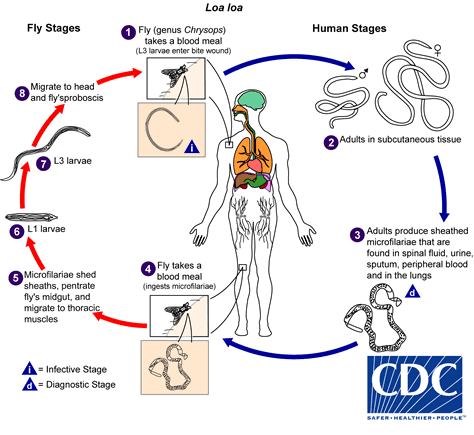Archive for the ‘Loiasis’ Category
Italy: Imported Loiasis and a novel therapeutic regimen
Monday, July 22nd, 2019Gobbi, F., Buonfrate, D., Tamarozzi, F., Degani, M., Angheben, A., & Bisoffi, Z. (2019). Efficacy of High-Dose Albendazole with Ivermectin for Treating Imported Loiasis, Italy. Emerging Infectious Diseases, 25(8), 1574-1576. https://dx.doi.org/10.3201/eid2508.190011.
Abstract
“We describe the outcomes of 16 cases of imported loiasis in Italy. Patients had microfilaremia <20,000/mL and were treated with high-dose albendazole for 28 days and a single dose of ivermectin. This combination might be an effective treatment option in nonendemic areas, when diethylcarbamazine, the drug of choice, is not available.”


CDC: The deerflies (genus Chrysops) that pass Loa loa on to humans bite during the day. If a deerfly eats infected blood from an infected human, the larvae (non-adult parasites) will infect cells in its abdomen. After 7–12 days the larvae develop the ability to infect humans. Then the larvae move to the mouth parts of the fly. When the deerfly breaks a human’s skin to eat blood, the larvae enter the wound and begin moving through the person’s body.
It takes about five months for larvae to become adult worms inside the human body. Larvae can become adults only inside the human body. The adult worms live between layers of connective tissue (e.g., ligaments, tendons) under the skin and between the thin layers of tissue that cover muscles (fascia). Fertilized females can make thousands of microfilariae a day. The microfilaria then move into the lymph vessels of the body (the lymph vessels contain the blood cells that fight infection). Eventually they move into the lungs where they spend most of their time. These microfilariae enter the blood from time to time, usually around midday. It takes five or more months for microfilariae to be found in the blood after someone is infected with Loa loa. The microfilariae can live up to one year in the human body. If they are not consumed in a blood meal by a deerfly they will die. Adult worms may live up to 17 years in the human body and can continue to make new microfilariae for much of this time.
Most people with loiasis do not have any symptoms. People who get infected while visiting areas with loiasis but do not come from areas where loiasis is found (travelers) are more likely to have symptoms. The most common manifestations of the disease are Calabar swellings and eye worm. Calabar swellings are localized, non-tender swellings usually found on the arms and legs and near joints. Itching can occur around the area of swelling or can occur all over the body. Eye worm is the visible movement of the adult worm across the surface of the eye. Eye worm can cause eye congestion, itching, pain, and light sensitivity. Although eye worm can be scary, it lasts less than one week (often just hours) and usually causes very little damage to the eye. People with loiasis can have itching all over the body (even when they do not have Calabar swellings), hives, muscle pains, joint pains, and tiredness. Sometimes adult worms can be seen moving under the skin. High numbers of blood cells called eosinophils are sometimes found on blood counts. Some people who are infected for many years may develop kidney damage though development of permanent kidney damage is not common. Other rare manifestations include painful swellings of lymph glands, scrotal swellings, inflammation of parts of the lungs, fluid collections around the lung, and scarring of heart muscle.

